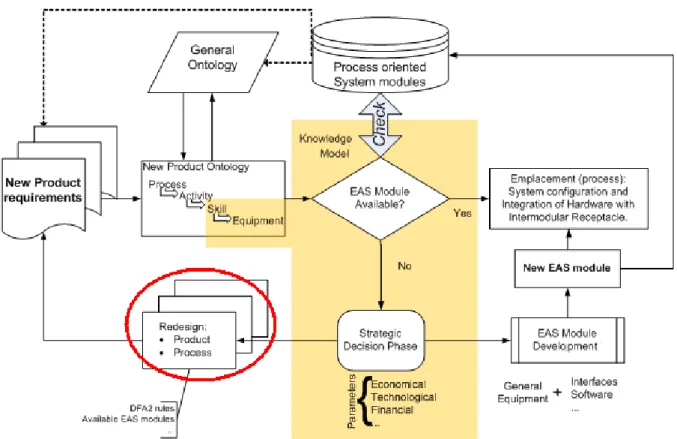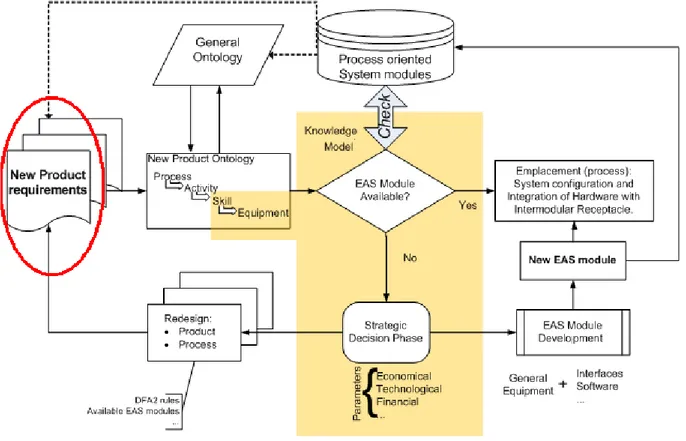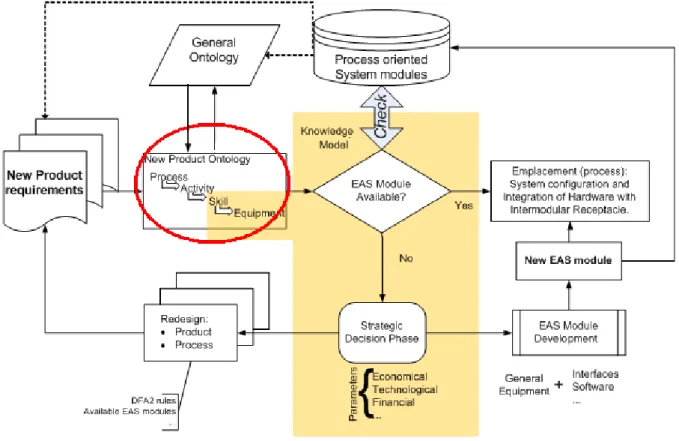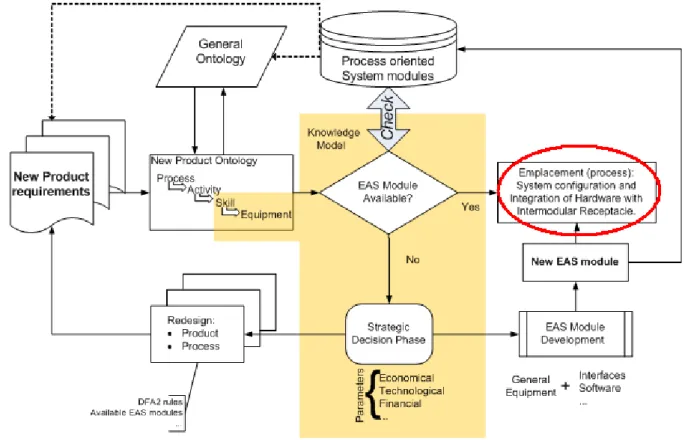Chapter 2: THIS PROJECT
2.1 General Purposes
This thesis is part of a research program which has the main goal to prove that the above mentioned Evolvable Paradigm can be introduced with success in present industry. Of course, in order to allows such a mind-changing, it should be a stepwise process, starting with small and valuable novelties.
An ideal Evolvable System would be composed on the hardware side by a referential structure with multiple interfaces for all the components (robots, conveyors, tool-warehouses, feeders...) and on the software side each component would be agentified and would be able to cooperate with the other process-oriented, task specific elements. As a result, the system would be able to configure itself and to perform new assembly processes without external hints.
2.2 Summary of the work’s steps
First of all, after read all the available literature about the topic, we produced the Evolvable Assembly System scheme presented in the chapter number 1. This scheme establish the guideline of the further work.
One of the most important aspect to consider in order to pass from a theoretical paradigm to a practical approach is the information management. In our view, all the necessary information should be provided by the ontology, and for this reason at the begin we put the focus on It.
Figure 6
Starting from an existing Ontology, developed for the EUPASS project our purpose has been to create a process-oriented General Ontology. In the third chapter the former ontology is presented: analysing it, all the weak points of such an approach surfaced and therefore, in the same chapter all the modification that we brought about are introduced.
Of course this refresh has been carried out accounting even of the control needs, especially the agentification requirements discussed during two weeks spent in UNINOVA with professor José Barata and his team.
The way we chose to prove that the Evolvable Paradigm could be used successfully is to exhibit how, two very different products, from the same company, could be assembled with the
which we got some information. From the whole amount of versions, we chose the most suitable for our purposes.
An initial overview of the products discloses that both the handle and the valve group had not a suitable design for automatic assembly. As you will see in the fourth chapter, it has been necessary to perform a DFAA analysis which allowed to evaluate the products. After the first evaluation we introduced some modifications to improve the score of such products. This step is showed in the next picture.
Figure 7. The Redesign phase has been useful to get suited requirement for automatic assembly.
Figure 8. At the end of this step, we got the final Product Requirements.
The further step has been to develop the Specific Ontologies for the Handle and for the Valve Group; of course the basic information came not only from the product requirements but also from discussions with peoples expert in assembly. In the ontologies we tried to highlight the importance of the Emergence Behaviour for such an approach. In the chapter number 5 we
Figure 9. New Product Ontology
The analysis of the product, and the Specific Ontologies lead us to a set of skills, and therefore equipments needed to accomplish the tasks. In the sixth chapter of this thesis a first attempt of the final layouts of the system is presented.
Figure 10. Layout final phase.
Since the character of our project, of course we had not any available EAS module.
The chosen elements for the layouts are already available in KTH workshop, and after a process of agentification and after the design of the adequate interfaces they will be part of the final cell
2.3 Limitations
The General Ontology we produced is not a static document, but it needs to be further developed and widened . When a new technology arises or the analysis on new products show new process requirements, the user should include new classes into the Ontology. In our work we present the most important processes and skills, but we did not include, for example all the equipments offered by the present market. We put the focus on the valuable classes of our test -case.
Moreover the Ontology does not deal with the integration between automatic and manual
assembly stations. Although all the most important kind of sensors have been included, the maintenance and diagnostic processes have not been investigated deeply.
All the discussions concerning the software aspects with professor Barata and his students lead us to create all the connections necessary for the Control among the Ontology’s classes. On one hand you will see in the ontology the top down relations useful for the Emplacement Process, on the other hand the bottom-up links, for the Control issues. Anyway, we did not study the Module agentification process.
As we stated at the beginning of this chapter, one of the most important aspect of the Evolvable Systems is the development of proper interfaces (Intermodular Receptacles): we leave their progress to further researches.
Evolvable Paradigm is very suitable for medium or low-volumes productions of complex products with not very long lifecycles. The economical analysis has been neglected in this thesis.



